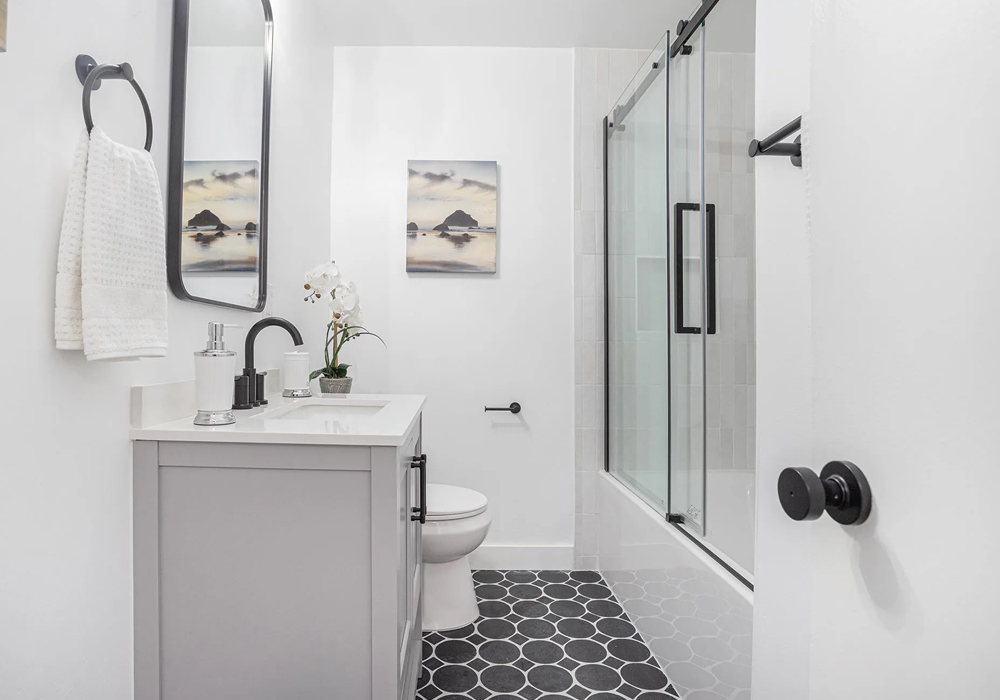Small Bathroom Remodel Ideas for Orange County Condos

Few home improvement projects deliver as much value as a bathroom remodel. When you’re dealing with a small space, it can have an even bigger impact on your day-to-day routine by enhancing the livability of a room you use every day. The complexity of a bathroom remodel can vary based on a variety of factors, including home type. Here, we’ll get into all the details to consider when planning a bathroom remodel in Orange County condos and townhomes, including design ideas and inspiration from our interior design experts.
Planning Your Condo Bathroom Remodel
Every good remodel starts with a clear, detailed plan. Thoughtfully planning out each step is critical for a project that stays on track and on budget and produces the desired results for a bathroom you love stepping into every day.
- Obtain Planning Permissions and Understand Condo Regulations
While planning and permits is a necessary step for any bathroom remodel project, remodels in condo buildings and townhomes come with specific regulations that you’ll need to follow in your project execution. Depending on the HOA policies, you may be required to abide by strict guidelines regarding materials, design, and what renovations are permitted. When planning your timeline, factor in the time it will take to submit plans for HOA approval, which is a requirement that can take weeks or months. Be sure to discuss your desired renovations with your HOA before beginning the remodel process to ensure they fall within the building’s guidelines and avoid unnecessary delays, changes, or complications during construction.
- Assess Existing Layout Constraints (Toilet, Plumbing, Entrance)
Layout constraints in your bathroom will impact the extent of changes you can make. In condo buildings, moving essential plumbing, especially toilets, is typically prohibited since the complex waste and soil management system affects multiple units. Altering or moving the entrance to your bathroom may also be prohibited by building regulations due to the risk of disturbing shared structural, electrical, and plumbing systems in surrounding units.
- Hiring Professionals: Contractors vs. Interior Designers
Especially with the complex requirements and restrictions, it’s a good idea to hire professionals to guide and execute your condo or townhome bathroom remodel. If you’re unsure why hiring professionals is important—or if you need both a contractor and an interior designer for your project—let’s discuss what both roles do and how they impact the experience and results of your remodel.
Why hire a contractor?
Contractors manage and execute the physical construction of a renovation. A general contractor coordinates subcontractors, including plumbers and electricians, and oversees all physical labor involved in the construction to ensure structural integrity and adherence to the remodel plans. They are responsible for managing the timeline and budget of the project to keep the work on track. Experienced professional contractors are well-versed in local building codes, bring technical expertise, and are skilled in project management.
Why hire an interior designer?
Interior designers specialize in aesthetics and functionality of a remodeling project. Their work revolves around creating the overall desired look and feel of the space through thoughtfully selected materials, including paint colors, flooring, tile, lighting, fixtures, and mirrors. They bring expertise in design principles, color theory, spatial planning, and knowledge of design software. Designers work with the client to understand aesthetic preferences, layout needs, and functional requirements to create plans for the contractor to follow.
- Budget Considerations and Cost Estimations
Arguably the most important step in the planning process is determining the budget for your bathroom remodel project. Without setting a realistic budget and getting accurate cost estimates, you run the risk of starting a project you cannot afford to finish. Working with professionals is helpful for this step, since contractors, architects, and designers have experience with building budgets and may even be able to help you get lower rates on materials. Make sure to get an itemized budget with all costs for every aspect of the project, including permits, materials, and labor and ensure you understand the payment schedule to avoid delays. It’s also important to include a contingency fund of 10–20% of the total budget to account for any unforeseen expenses.
{{cta-banner}}
Maximizing Space and Storage
With limited space, maximizing available area usage and storage options is a top priority, especially in a bathroom. With a few smart design choices, you can optimize the functionality of your bathroom and add ease to your daily routine.
- Optimize Storage Capacity with Cabinets, Shelving, and Hidden Storage
When it comes to creating adequate storage space in a small bathroom, creative solutions are key. Take advantage of vertical space by adding wall shelving or over-the-door organizers to keep countertops clear of clutter. Pull-out drawers, tiered shelving, and stackable bins under the sink provide helpful storage solutions if you prefer to keep your toiletries and bathroom products concealed. For added storage in the shower, consider recessed niches, corner shelves, or vertical towers to keep your shower essentials organized. Don’t underestimate the storage capacity of a medicine cabinet—replacing your standard mirror with a medicine cabinet provides extra hidden storage with easy access for the items you use in your daily routine.
- Multi-Functional Fixtures and Space-Saving Solutions
Make smart use of your bathroom with multi-functional fixtures that save space while adding efficiency to your hygiene routine. In addition to mirrored medicine cabinets, a showerhead with a built-in handheld option or faucet with adjustable, retractable features provide improved accessibility plus convenience with two fixtures in one sleek, compact water source.
Your choice of vanity can also add multi-functional benefits. Look for vanities with plenty of vertical storage space like built-in drawers, shelving or racks installed on cabinet doors, and adjustable dividers to adapt to your needs.
- Small Bathroom Layouts That Improve Functionality
With a few simple design changes, you can enhance your bathroom’s functionality significantly. By installing space-saving fixtures and features like a walk-in shower with a frameless glass door, a wall-mounted vanity or toilet, or a corner bath or shower, you can open up more floor space to make the room feel larger. Implementing vertical storage is also a benefit here, making the most of usable wall space. If the architecture of your bathroom and surrounding room allows, a pocket door can help you work around space limitations more effectively.
Bathroom Fixtures and Upgrades
With the right fixtures and a few smart upgrades, you can make a small bathroom function smoothly and feel more open.
- Tub to Shower Conversions for Small Spaces
One of the biggest space-saving updates to consider is converting a tub into a walk-in shower. To create the illusion of even more space, opt for a frameless glass door or enclosure.
- Freestanding vs. Built-In Bathtubs
While freestanding tubs can make a statement and create a spa-like atmosphere in your bathroom, they typically come with higher costs, more challenging installation and cleaning, and require more space. Built-in tubs are the more practical option and offer space savings, plus the built-in ledge also provides more storage space.
- Lavatory Sinks and Vanity Options
Sinks and vanities are a great place to add more storage space and functionality to your small bathroom. To compensate for limited countertop space, prioritize options that offer drawers or shelving to take advantage of vertical and under-sink space. If floorspace is the challenge you’re looking to solve, options like floating vanities and pedestal sinks may be the right choice for your space. For even more challenging space restrictions, a corner vanity in an unused corner may be the best space-saving option.
- Shower Seating and Accessibility Considerations
If accessibility is a top concern for your small bathroom remodel, focus on creating ample clearance for easy navigation through the space. Depending on needs, grab bars, a higher toilet, curbless shower, or a wall-mounted sink with knee clearance are a few features to consider. While there are plenty of temporary shower seating options available, you may want to incorporate a fixed shower seat or bench along the shower wall for a more comfortable and stable option. Other important considerations include non-slip flooring, lever-style door handles, and adequate, accessible lighting.
- Quality Lighting: Task, Ambient, and Accent Lighting
Lighting has a massive impact on how a room looks and feels, and a bathroom is no exception, especially if it’s lacking natural light. Keep the space feeling bright and airy with layered, high-quality lighting. A mix of task, ambient, and accent lighting can add depth, making the space feel larger and more open while also improving visibility.
- Elevated Fixtures and Hardware for Style and Function
Particularly in small bathrooms, it’s essential to balance style and function in your design decisions. Fixtures like wall-mounted faucets, dual-function showerheads, and mirrored medicine cabinets are ideal for small spaces thanks to their space-saving benefits and can also add visual interest with a variety of elevated style and finish options. Selecting sleek, streamlined hardware can support your space-saving efforts and offer more storage solutions like towel racks and hooks.
Design Elements and Finishes
The finishing touches of your bathroom design can impact the overall feel of your bathroom space, so don’t overlook these details when planning your design.
- Wall Trends: Light Colors, Patterns, and Textures
It’s common knowledge that light colors light white or soft gray can reflect light, which helps a small room feel more spacious. Keeping colors light and bright, from paint shades and decor to furniture and flooring, is a simple solution to help the space feel less cramped. Adding patterns and texture through tile, wallpaper, or flooring is an unexpected but effective way to add depth and create the perception of a larger space.
- Flooring Options: Elevated Bathroom Flooring for Visual Impact
In a small bathroom, flooring is the perfect place to add your personal style without sacrificing valuable square footage. Opt for a bold patterned tile or creative arrangement or vinyl or wood plank flooring to create a statement-making focal point.
- Countertops, Cabinetry, and Material Mix-Up
When selecting countertops for your small bathroom remodel, aim for high durability. Materials like quartz and granite can strike the right balance of durability and aesthetic appeal to last for years to come. These options also offer easy maintenance, which is an important factor to consider in your bathroom design.
Your choice of cabinetry should prioritize storage efficiency and space optimization. In small spaces, cabinetry is at a premium, so design around maximizing space with built-in drawers and shelving. Choosing light colors for your bathroom cabinets can also create the illusion of a more open space.
Personalize the style of your bathroom by mixing materials with different textures, tones, and finishes. This adds more visual interest and draws the eye to the unique details of your bathroom design instead of the spatial limitations.
- Patterns, Textiles, and Decorative Elements
Many people think that the only way to make a room feel larger is to go with an all-white aesthetic, but bold patterns and decor can actually help to create the perception of more space. Try large-scale patterned wallpaper or large tiles to achieve this. Adding a mix of textiles can add impactful texture to the space—create contrast with a rug, shower curtain, or towels for a pop of color or pattern.
- Adding Luxury: Steam Showers and Statement Features
One way to add a mix of luxury and function is with a steam shower upgrade. The complexity of a steam shower installation depends on the supply available in your power panel and may require additional planning, so be sure to consult a professional if you’re considering this upgrade.
Tips for a Stress-Free Remodel
With the right guidance and knowledge, you can take excess stress out of your small bathroom remodel project.
- Focus on Function Over Form
When working with small spaces, functionality should be the priority. While the aesthetics are important, how your bathroom operates will have the biggest impact on your day-to-day routine.
- Consider Condo-Specific Restrictions (Plumbing, Doorways, Structural Limits)
In a condo, be sure to factor in all the restrictions that might limit the possible upgrades you can make to your bathroom. Communicate with your HOA to ensure your bathroom remodel follows your building’s regulations.
- Communicate Effectively with Contractors and Designers
Communication can make or break a remodel project, so it’s important to maintain a clear line of communication with your contractors and designers. Establish that relationship early in the process so that all parties have clear communication expectations.
- Maintain Air Quality and Safety During Renovation
While your bathroom is being renovated, health and safety should be a top consideration. On top of choosing low-VOC materials, open windows and use fans for ventilation and seal off work zones to keep dust contained. If completing any of the work yourself, use personal protective equipment while handling construction materials.
Inspiration and Resources
Ready to plan your bathroom remodel project? Get started with some of our favorite design inspiration and tips.
- Popular Small Bathroom Layouts for Condos and Townhomes
Check out our top layout ideas for smaller bathrooms here.
- Professional Designer Tips and Tricks
- Top Resources for Planning a Condo Bathroom Remodel
When planning a condo bathroom remodel, we recommend contacting professional contractors and designers to guide you through the process. Learn more about cost, ideas, and important factors to consider from our design experts here.
Final Thoughts
- Summary of Key Remodel Ideas
As you’re preparing for your bathroom remodel, you’ll likely have a lot of ideas you want to explore. To help you narrow your focus, prioritize ideas that help create a spacious, open feel and maximize storage and function, but be sure to leave room for your personal style to shine through. After all, you should love the look of the end result, too.
- Practical Steps for a Successful Small Bathroom Remodel
To ensure project success, keep these steps in mind:
- Set a realistic budget
- Hire professionals for the execution
- Create a functional layout
- Choose materials that enhance the space
- Follow the proper order of operation for construction and finishing touches
With careful planning and clear goals, you’ll ensure that the end result provides you with a bathroom that functions well, looks beautiful, and adds ease to your everyday routine.
Amanda Steele, a Sales Expert at Revive, previously a Realtor with Berkshire Hathaway, excels in real estate knowledge and customer service. Her skills significantly enhance Revive's client experiences.
Recent articles
Unlocking equity is hard,
we've got your back.
See what's possible, it's your real estate.
Discuss homeThe future
starts at home.
While there is an abundance of evidence that supports that renovated turnkey homes sell faster and for more, Revive, nor the Contractor, can guarantee a specific as-is or after renovation value or the exact time that it would take to get a renovated home sold. Further, Revive cannot provide a guarantee that the real estate market will not experience fluctuations or a decrease during the renovation or sales period.








